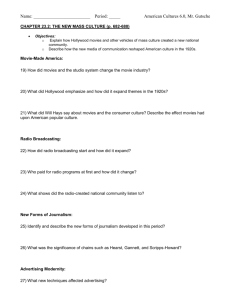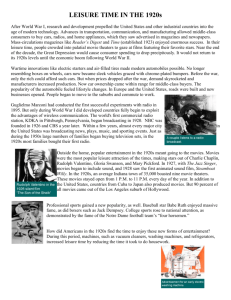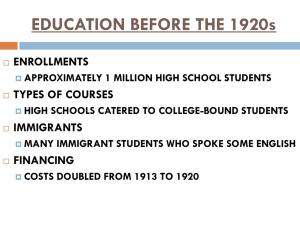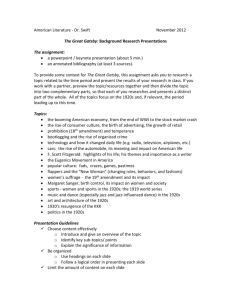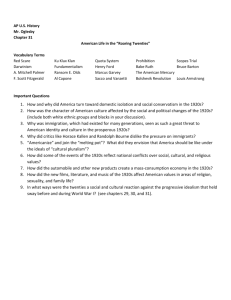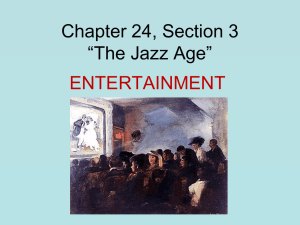chapter 20 section 4 note blank
advertisement
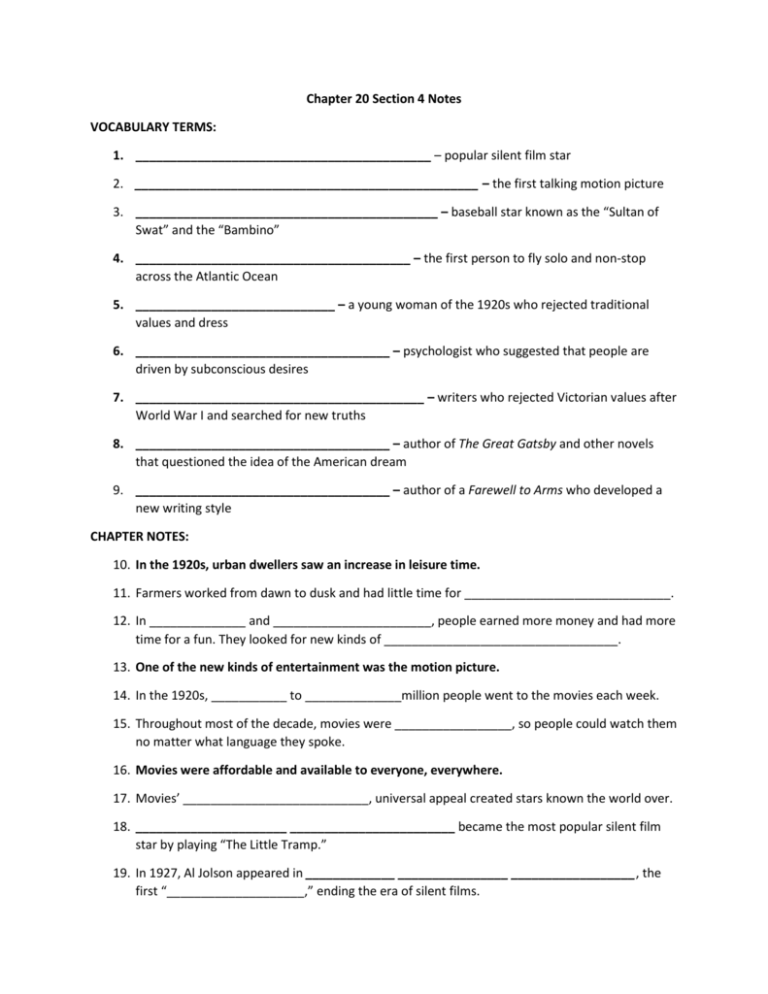
Chapter 20 Section 4 Notes VOCABULARY TERMS: 1. ___________________________________________ – popular silent film star 2. __________________________________________________ – the first talking motion picture 3. ____________________________________________ – baseball star known as the “Sultan of Swat” and the “Bambino” 4. ________________________________________ – the first person to fly solo and non-stop across the Atlantic Ocean 5. _____________________________ – a young woman of the 1920s who rejected traditional values and dress 6. _____________________________________ – psychologist who suggested that people are driven by subconscious desires 7. __________________________________________ – writers who rejected Victorian values after World War I and searched for new truths 8. _____________________________________ – author of The Great Gatsby and other novels that questioned the idea of the American dream 9. _____________________________________ – author of a Farewell to Arms who developed a new writing style CHAPTER NOTES: 10. In the 1920s, urban dwellers saw an increase in leisure time. 11. Farmers worked from dawn to dusk and had little time for ______________________________. 12. In ______________ and _______________________, people earned more money and had more time for a fun. They looked for new kinds of __________________________________. 13. One of the new kinds of entertainment was the motion picture. 14. In the 1920s, ___________ to ______________million people went to the movies each week. 15. Throughout most of the decade, movies were _________________, so people could watch them no matter what language they spoke. 16. Movies were affordable and available to everyone, everywhere. 17. Movies’ ___________________________, universal appeal created stars known the world over. 18. ______________________ ________________________ became the most popular silent film star by playing “The Little Tramp.” 19. In 1927, Al Jolson appeared in _____________ ________________ __________________, the first “____________________,” ending the era of silent films. 20. The radio and the phonograph were powerful instruments of mass culture. 21. The first commercial radio station, ________, began in 1920. 22. Within three years, there were __________radio stations. 23. People all over the country could hear the same______________, _____________, and ____________. 24. With ______________________________, people could listen to music whenever they wanted. 25. Improvements in ___________________________ technology made records popular. 26. People listened to the same ______________and learned the same ______________________. 27. The world of sports produced some nationally famous heroes. 28. Thanks to ______________________________and ________________, millions of people could follow their favorite athletes. 29. Baseball player ____________ _____________, nicknamed “The Sultan of Swat,” thrilled people with his home runs. 30. Aviator Charles Lindbergh became a national hero when he made the first solo flight across the Atlantic. 31. Aviator Charles Lindbergh became a national hero when he made the first solo flight across the Atlantic. 32. In May 1927, ___________________________ flew his single-engine plane, _______________ ___ _____ ________________, non-stop from New York to Paris. 33. The flight took more than ________hours. 34. Women’s roles also changed in the 1920s. 35. Women married___________, had fewer____________________, and generally lived _____________, ___________________ lives. 36. Labor-saving appliances, such as electric ______________ and ________________________ ________________, allowed time for book clubs, charitable work, and new personal interests. 37. Such changes benefited ______________ women more than______________ women. 38. ________________________represented a “revolution in manners and morals.” 39. These young women rejected___________________________ morality and values. 40. They wore short skirts, cut their hair in a short style called the ___________, and followed dance crazes such as the _______________________________. 41. The decade saw many “firsts” for women. 42. More women entered the _____________________________. 43. They moved into new fields such as ______________________, __________________, __________________________, and ___________________________. 44. _____________ ___________ _______________ of Wyoming became the first female governor. 45. Other “firsts” included the first woman ________________ and the first woman elected to the __________ __________________. 46. World War I strongly affected the art and literature of the 1920s. 47. The war’s devastation left many questioning the ______________________Victorian attitude of progress. 48. ____________________________ expressed a skeptical, pessimistic view of the world. 49. Writers and artists explored the ideas of psychologist Sigmund Freud, who suggested that human behavior was driven by __________________desires. 50. Artists such as ______________ ____________________, ________________ ______________, and __________________________ __’ _________________ challenged tradition and experimented with new subjects and abstract styles. 51. Writers of the 1920s were called the Lost Generation because they’d lost faith in Victorian cultural values. 52. ____ _________________ __________________________ explored the idea of the American dream, writing that his generation had found “all faiths in man shaken.” 53. __________________ _________________________ questioned concepts of personal sacrifice, glory, honor, and war and created a new style of writing. 54. Playwright ________________ ___’_____________ explored the subconscious mind in his plays.

